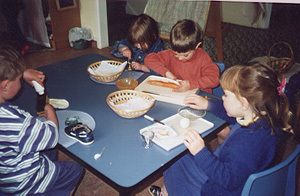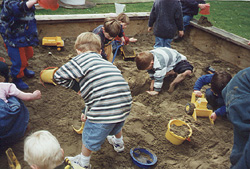| The Montessori Programme |
Practical life exercises involve dressing skills,
care of the environment, pouring, polishing, cleaning, preparing vegetables
and fruit, baking and sewing - tasks which promote co-ordinated movement.
They are designed to foster independence, self-control, co-ordination of
the hand and concentration. |
| Sensorial Material exercises allow the child to
manipulate and classify objects in the environment. All five senses are
utilised as the child learns to make finer distinction in quality and gradation.
Blindfolded games help to form mental images of concrete objects, paving
the way to abstract thinking. The Montessori sensorial apparatus assists
the child in learning to differentiate between: sizes, colours, weights,
textures, musical sounds, odours and tastes. They help the child organise,
classify, and give a language to the sensory experiences he/she has received
since birth. |
Language instruction begins at two and half (or
when the child begins at the Children’s House) with vocabulary enrichment.
A phonetic approach to reading is incorporated with a  sight-sound-touch
presentation of the alphabet. As the child is ready they learn to manipulate
cut out letters for word construction. Reading generally follows as a natural
event. Whole language experience is provided to aid in the development
of reading and writing skills creating the basis on which the child continues
to build in the 6-9 class. sight-sound-touch
presentation of the alphabet. As the child is ready they learn to manipulate
cut out letters for word construction. Reading generally follows as a natural
event. Whole language experience is provided to aid in the development
of reading and writing skills creating the basis on which the child continues
to build in the 6-9 class. |
| Mathematics is a continuation of the earlier sensorial
material integration. The child works from the concrete towards abstraction
through repeated sensorial impressions of geometry, relationships of quantity,
the processes of addition, multiplication, subtraction and division. These
muscular impressions are continued in a more abstract form at the primary
level. The 3-6 child is a fact seeker. Consequently, this is the time for
the foundation of memorisation of math facts. |
| Geography, History and Science lessons provide
the child with a store of factual information and impressions of various
cultures, land formations, eco-systems and the interrelationships of all
parts of the earth. Environmental education forms part of the learning
experience, both indoors and out. |
| Art, Music and Drama are experienced as an integral
part of the child’s daily work. Creative expression and developmental skills
rather than end results are encouraged in these areas. As cultural extensions,
many projects are related to the child’s exploration in history, geography
and science. |
Physical Development is nurtured through movement
and physical co-ordination exercises. In the classroom the materials help
develop gross and fine motor control. Gross motor control is also fostered
by outside activities. |